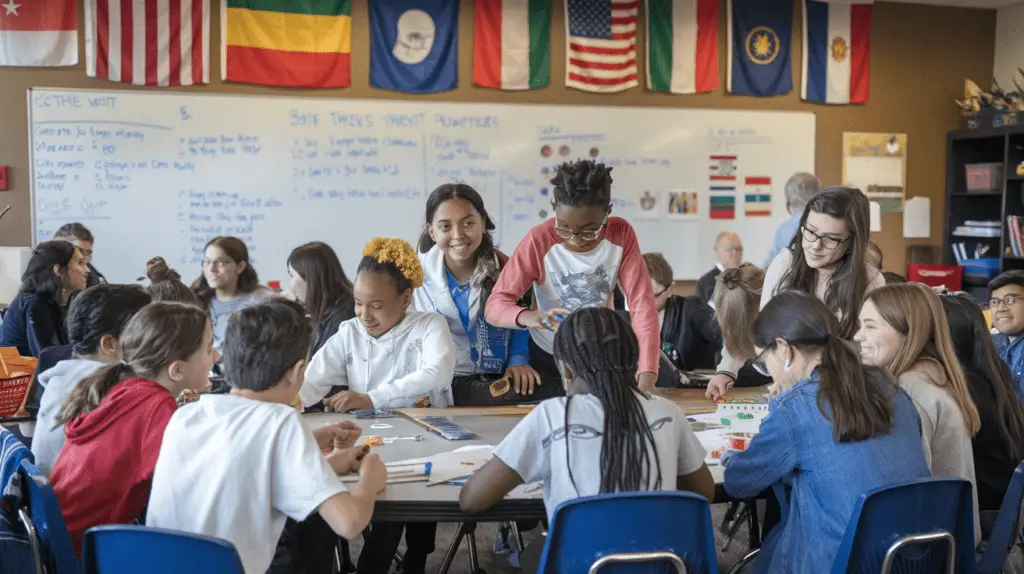In today’s interconnected world, intercultural competence development has become an essential skill for students to thrive in their future careers and personal lives. As educators, we have the unique opportunity to shape the next generation of global citizens. Are you ready to transform your classroom into a hub of global understanding and cultural awareness? Class2Class is here to help you navigate this exciting journey.
At Class2Class, we understand the challenges teachers face in fostering intercultural competence. That’s why we’ve created a revolutionary platform that connects classrooms around the world, making it easier than ever to integrate global perspectives into your curriculum. Let’s explore five powerful strategies that will help you cultivate intercultural competence in your students and prepare them for a diverse, interconnected future.
1. Embrace Virtual Cultural Exchanges for Enhanced Intercultural Competence Development
Gone are the days when cultural exchanges were limited to expensive field trips or pen pal programs. With Class2Class, you can bring the world to your classroom with just a few clicks. Our platform facilitates real-time virtual exchanges between students from different countries, allowing them to engage in meaningful conversations and collaborative projects.
Imagine your students discussing environmental issues with peers from Brazil, or collaborating on a math project with classmates in Japan. These authentic interactions not only improve language skills but also develop empathy, curiosity, and respect for different cultures. By participating in these exchanges, students gain firsthand experience in navigating cultural differences and finding common ground – key components of intercultural competence development.
Virtual cultural exchanges provide a safe and structured environment for students to practice their intercultural communication skills. They learn to adapt their communication style, ask thoughtful questions, and listen actively to understand different perspectives. These experiences help students develop cultural sensitivity and adaptability, essential traits for success in a globalized world.
2. Integrate Global Perspectives into Your Curriculum for Comprehensive Intercultural Learning
Intercultural competence development isn’t a standalone subject – it should be woven into every aspect of your teaching. Class2Class provides a wealth of resources and project ideas that align with various subjects and grade levels, making it easy to incorporate global perspectives into your existing curriculum.
For example, in a history class, you could explore how different cultures interpret historical events. This approach helps students understand that there are multiple narratives and perspectives on historical occurrences, fostering critical thinking and cultural relativism. In science, you might investigate how climate change affects communities around the world differently, highlighting the interconnectedness of global issues and the need for cross-cultural cooperation.
In literature classes, you can introduce texts from diverse authors, exposing students to different storytelling traditions and cultural values. Math classes can explore various counting systems from around the world, demonstrating how mathematical concepts can be expressed differently across cultures.
By consistently exposing students to diverse viewpoints and experiences, you’re helping them develop a more nuanced understanding of the world and their place in it. This approach not only enhances intercultural competence but also makes learning more engaging and relevant to students’ lives in our increasingly interconnected world.

3. Harness the Power of Project-Based Learning for Practical Intercultural Competence Development
One of the most effective ways to develop intercultural competence is through hands-on, collaborative projects. Class2Class offers a range of project-based learning opportunities that encourage students to work together across cultural boundaries to solve real-world problems.
Consider a project where students from different countries collaborate to design a sustainable city of the future. This not only teaches them about urban planning and environmental science but also requires them to negotiate different cultural perspectives on sustainability and urban living. Through such projects, students learn to communicate effectively across cultures, resolve conflicts, and appreciate diverse approaches to problem-solving.
Project-based learning provides a practical context for intercultural competence development. Students must navigate time zone differences, language barriers, and varying work styles to achieve a common goal. They learn to leverage the strengths of diversity, recognizing that different cultural backgrounds can bring unique insights and solutions to complex problems.
These projects also help students develop important 21st-century skills such as digital literacy, teamwork, and adaptability. By working on meaningful projects with global implications, students see the real-world relevance of their learning and become more motivated to engage with different cultures.
4. Leverage Technology for Immersive Cultural Experiences
While nothing can replace the experience of physically visiting another country, technology can provide immersive cultural experiences that were once unimaginable. Class2Class harnesses cutting-edge technology to bring cultural immersion into your classroom, significantly enhancing intercultural competence development.
Virtual reality tours of historical sites, interactive language learning games, and live streaming of cultural events are just a few ways we help students explore different cultures without leaving the classroom. These experiences spark curiosity and create emotional connections that are crucial for developing intercultural empathy and understanding.
For instance, students can take a virtual tour of the Louvre in Paris, exploring world-renowned artworks while learning about French culture and history. They can participate in a live-streamed traditional tea ceremony from Japan, gaining insights into Japanese customs and etiquette. These immersive experiences go beyond textbook learning, allowing students to feel as if they’re truly experiencing another culture.
Moreover, Class2Class provides access to online language exchange partners, allowing students to practice their language skills with native speakers. This not only improves their language proficiency but also provides authentic cultural exchanges, helping students understand colloquialisms, idioms, and cultural nuances that are often missed in traditional language classes.
By leveraging these technological tools, you’re providing your students with rich, multi-sensory experiences that deepen their cultural understanding and accelerate their intercultural competence development.
5. Encourage Reflection and Self-Awareness for Lasting Intercultural Competence
Intercultural competence development isn’t just about learning about others – it’s also about understanding oneself. Class2Class provides tools and resources to help students reflect on their own cultural identities and biases, a critical step in developing true intercultural competence.
Guided reflection activities, cultural identity mapping exercises, and peer-to-peer discussions encourage students to examine their own cultural lenses and how these influence their perceptions of others. This self-awareness is crucial for developing the flexibility and open-mindedness needed for true intercultural competence.
For example, after a virtual exchange or collaborative project, students might complete a reflective journal entry about their experience. They could explore questions such as: What surprised them about the interaction? What assumptions did they have that were challenged? How did their own cultural background influence their approach to the project?
Class2Class also offers interactive modules on topics like implicit bias and cultural value dimensions. These help students understand how their cultural background shapes their worldview and influences their interactions with others. By recognizing their own biases and cultural conditioning, students become more open to different perspectives and better equipped to navigate cross-cultural situations.
Regular reflection exercises help students track their progress in intercultural competence development over time. They can set personal goals for improvement and celebrate their growth as they become more culturally aware and adaptable.

Join the Global Classroom Movement with Class2Class
At Class2Class, we’re not just providing a platform – we’re building a community of educators committed to fostering global citizenship and intercultural competence development. When you join our network, you gain access to a wealth of resources and opportunities:
A vast library of culturally diverse teaching resources: Our platform offers a rich collection of lesson plans, activities, and materials designed to promote intercultural learning across various subjects and grade levels. These resources are continually updated and expanded, ensuring you always have fresh, relevant content to engage your students.
Professional development opportunities focused on intercultural competence: We offer webinars, online courses, and workshops led by experts in the field of intercultural education. These opportunities allow you to deepen your own intercultural competence and learn best practices for fostering it in your students.
A supportive community of like-minded educators from around the world: Connect with teachers from diverse cultural backgrounds who share your passion for global education. Exchange ideas, collaborate on projects, and learn from each other’s experiences in promoting intercultural competence development.
Ongoing support and guidance from our dedicated team: Our experienced staff is always available to assist you in making the most of the Class2Class platform. Whether you need help setting up a virtual exchange, troubleshooting technical issues, or brainstorming project ideas, we’re here to support you every step of the way.
Sign up
Don’t let your students miss out on the incredible opportunities for intercultural competence development. Join Class2Class today and start your journey towards creating a more globally aware and culturally competent classroom.
As one of our community members, Maria S., an 8th-grade teacher from Spain, shares: “Class2Class has opened my students’ eyes to the world. They’re not just learning about other cultures; they’re actively engaging with them. It’s been transformative for their intercultural competence development.”
Are you ready to revolutionize your teaching and prepare your students for a global future? Take the first step towards intercultural competence development in your classroom.
By embracing these strategies and leveraging the power of Class2Class, you’re not just teaching – you’re shaping the global citizens of tomorrow. Join us in our mission to make intercultural competence development an integral part of education worldwide.
For more information on how Class2Class aligns with the UN Sustainable Development Goals (SDGs) and supports Education for Sustainable Development (ESD), visit our dedicated page on Global Citizenship Education and the SDGs.
Remember, in today’s interconnected world, intercultural competence is not just an advantage – it’s a necessity. Let’s work together to ensure our students are prepared to thrive in a diverse and global society. Start your journey with Class2Class today and unlock the full potential of intercultural competence development in your classroom.


